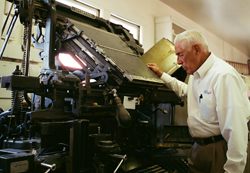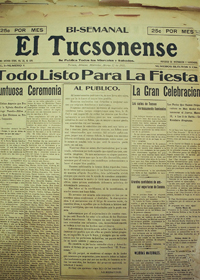Old Pueblo Printers y El Tucsonense

Albert M. Elias stands next to a 1914 linotype, the typesetting machine that helped to print the El Tucsonense newspaper in the early years.
photo: Steve Renzi
Standing next to a vintage 1914 linotype machine, in the backroom of Downtown’s Old Pueblo Printers at 255 S. Stone Ave., 85-year-old Albert M. Elias is reminiscing about the days he worked for the Spanish-language newspaper El Tucsonense.
“My grandfather, Francisco S. Moreno, founded the paper in 1915 and served as the publisher and printer until 1929. The paper was published here in this building, typeset on this machine, starting in 1922. After my grandfather died in 1929, my grandmother Rosa Elias Moreno took over as publisher. She had five children, four sons and one daughter, the boys all became printers and the daughter is my mother,” Elias shares.
At the turn of the last century, in 1900, the population of Tucson was about evenly divided between Hispanic and Anglo residents. Let’s not forget, Tucson was once a part of Mexico—an isolated frontier outpost in the midst of a hostile desert environment. As a part of Mexico, the capital in Mexico City was a long, forbidding 1,500 miles away. Under appreciated by many people, the Hispanic pioneers who settled here were resourceful, resilient and independent. They established the traditions and set the stage for those who came after them.
Those traditions included both a pride in the home country, most Tucson Hispanics came from Mexico, and a pride in the Spanish language. In the early 1900s, Tucson was the largest and most sophisticated center of the Hispanic population between El Paso and Los Angeles, according to the book Los Tucsonenses by Thomas E. Sheridan. Tucson had Hispanic entrepreneurs, businessmen, politicians and owners of grocery stores, barbershops and meat markets—in other words, a middle class.
“Their prominence gave Tucson a bicultural vitality unique to the Southwest,” Sheridan scribed in Los Tucsonenses.

The first issue of El Tucsonense.
photo: Steve Renzi
One aspect of that bicultural vitality was Spanish-language newspapers. There were many of them and they were an important forum for Hispanic political and day-to-day life. They covered the news of the United States and Mexico, they covered people and events in the Tucson barrios that the Anglo mainstream press typically ignored, and they were an outlet for Hispanic writers, intellectuals and poets. There was El Fronterizo, El Mosquito and the biggest and longest lasting of them all—El Tucsonense.
“I started working for El Tucsonense as a paperboy on my bicycle in the late 1930s,” Elias recalls. “It came two, sometimes three times a week. It was an afternoon paper, about four to eight pages. Cost 25 cents a week.
“During high school I moved into the print shop and began to learn the printing trade. I got out of Tucson High at 1 o’clock and worked in the print shop seven hours a day. I was a ‘printer’s devil’—an apprentice printer. I learned how to become a typesetter, a compositor who puts the pages together and a pressman who runs the press.
“It was all hands-on, labor-intensive… Everything had to be assembled, typeset and taken to press. A single page may take up to six hours,” Elias explains.
Elias’ favorite part of the paper was the local sports (deportiva) section, especially baseball.
“My uncles played baseball on a local semi-pro level team called the Tucson Aztecas. They played at Riverside field on West Congress, where the freeway is now. There was also Eagle field on 16th Street, where the Barrio Brewery is (now) and they played at Hi Corbett field before it was named that. I also remember boxing matches at the Labor Temple and wrestling and boxing at the Sports Center on West Congress.”
Elias’s love of baseball was shared later by another young employee at the print shop named Arturo Moreno, who is now the owner of the Los Angeles Angels major league baseball team.
El Tucsonense covered local, national and even international news. It had sports, political cartoons, comics and advertisements printed in Spanish and English. It also had good journalists. Elias remembered Editor Ricardo Fierro as one of the best.
“He was a one-man newspaper—he could do it all,” Elias states with conviction.
El Tucsonense began in 1915 and lasted until 1962. Fortunately, the entire collection of newspapers has been saved and is now preserved at the University of Arizona in Special Collections. It can be accessed online at Library.arizona.edu/contentdm/mmap/.
Old Pueblo Printers is still going strong as a commercial printing company. In 1966, Albert M. Elias and a partner, Oscar Araiza became co-owners. Elias became sole owner after 1990. At 85-years-old, he still goes to work every day.
Old Pueblo Printers is located at 255 S. Stone Ave. Hours are Monday-Friday, 8 a.m. to 4:30 p.m. Phone (520) 624-5851 with inquiries.
Category: Community, DOWNTOWN / UNIVERSITY / 4TH AVE




